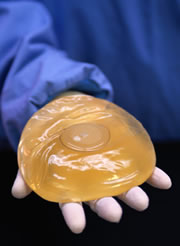| Home | ||||
| News | ||||
| Features | ||||
| Columns & blogs | ||||
|
||||
| Specials | ||||
| In focus | ||||
| Stories by subject | ||||
|
||||||||||||||||||||||||||||||||||
| |||||||||||||||||||||||||||||||||
| Feedback | ||
| About this site | ||
| About us | ||
| For librarians | ||
| TOP STORIES |
| NPG PROMOTION |
| News | ||||||||||||||
Published online: 09 February 2004;
| doi:10.1038/news040202-19
Fat used to boost breasts
Surgeons frequently shuffle handfuls of fat from the hips up to the face for cosmetic reasons - to smooth out wrinkles or cover up scars, for example. But they have been wary of moving fat into the breasts. In the 1980s, doctors found that a proportion of grafted tissue tends to die and form hardened areas. If fat has been transferred to the breast, these hardened areas can show up on mammograms and might be mistaken for tumours. So using fat to increase cup size is "kind of taboo", says plastic surgeon Adam Katz of the University of Virginia, Charlottesville. But Kotaro Yoshimura of the University of Tokyo and his colleagues think they might be able to avoid this problem by using a mix of fat cells and stem cells. The stem cells may create fresh fat cells and coax blood vessels to grow into and nurture the new tissue, says Yoshimura. This should boost tissue survival. Yoshimura and his team carried out the procedure on their first patient on 21 January, and they plan to do 30 more operations after obtaining approval from a review board. The women are undergoing the surgery for cosmetic reasons. During the operation, the team suck fat cells from the woman's stomach or thigh. By separating cells based on their density, the team enrich the slurry for special stem cells that are able to generate new fat cells. They then inject 300-400 millilitres of these stem cells mixed with normal fat tissue into the woman's breasts. More natural than silicone Around 240,000 women underwent breast augmentation in the United States in 2002. Most breast enhancements are done by implanting packets of saline water. The use of silicone implants is now restricted in the United States because of concerns that they can leak, causing serious side effects. Around a third of implants are removed within ten years because of complications. Using a person's own fat is an attractive alternative to these artificial implants because it does not provoke the immune system and looks completely natural. Also, women are rarely sorry to donate a few pounds of their own fat to the cause. "There's no other tissue you can take that amount of," says Marc Hedrick of the University of California, Los Angeles, and chief scientific officer for MacroPore Biosurgery in San Diego, California. The idea of using stem cells from fat isn't completely new. Two other groups have tried transplanting fat stem cells to rejuvenate the faces of a small group of patients, says Hedrick. Yoshimura's stem-cell trial is the biggest so far, he adds. Katz says he would like to see more trials on animals and in other areas of the human body before trying the technique on breasts. But Hedrick is more optimistic: "There's a good shot that this will work," he says. Hedrick believes that fat stem cells will one day find a broader use in repairing heart muscle and bone fractures and in other developing stem-cell therapies. But it is not yet clear how to coax such cells into becoming muscle, bone or blood, he says. In preparation for future therapies, MacroPore Biosurgery are already offering people who have had liposuction the opportunity to bank their fat stem cells. "I think it's crazy to throw them away," Hedrick says. |
||||||||||||||

